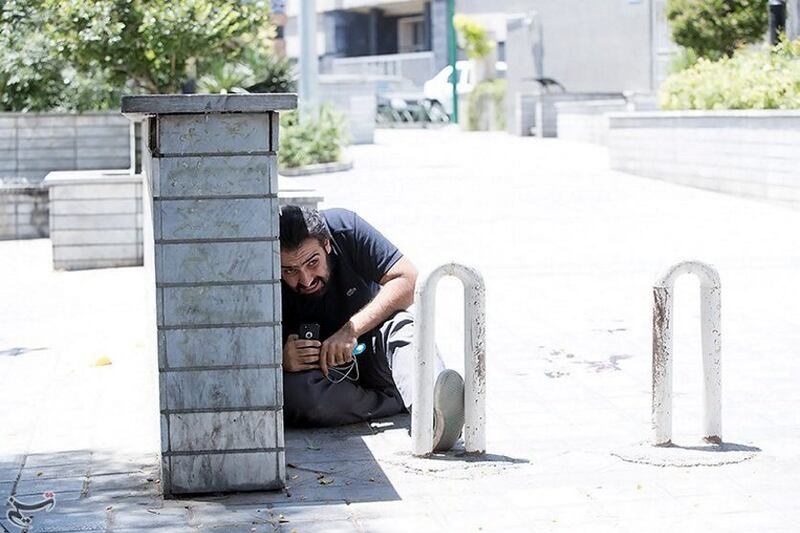Tehran // Twelve people were killed when gunmen and suicide bombers stormed Iran’s parliament and the shrine of its revolutionary leader on Wednesday.
The attacks, which injured dozens of people, were the first in the country to be claimed by ISIL.
They targeted two of Iran’s most potent symbols: its parliament complex in central Tehran and the mausoleum of Ayatollah Ruhollah Khomeini who led the 1979 Islamic revolution.
President Hassan Rouhani responded by calling for global unity against violent extremism.
“Iran’s message as always is that terrorism is a global problem, and unity to fight extremism, violence and terrorism with regional and international cooperation is the most important need of today’s world,” he said.
The UAE Minister of State for Foreign Affairs, Dr Anwar Gargash, condemned the attacks.
“Any terrorist attack in any country, in any capital, directed at innocent people is something that the UAE abhors and the UAE condemns”, he said.

The assaults began mid-morning when four gunmen burst into the parliament complex, killing a guard and one other person, ISNA news agency reported.
Another official said they were dressed as women and entered through the visitors’ entrance. One eventually exploded a suicide vest while the others were killed by security forces.
One man, recovering in a hospital bed, told state TV he was waiting to meet an MP when the shooting began.
“I was in the visitors’ lobby and suddenly shooting began. There were women and children. I escaped towards the parliament, and was shot in the leg while running,” he said.
At roughly the same time, two assailants entered the grounds of the Khomeini mausoleum, killing a gardener and wounding several other people.
One detonated a suicide vest, while the other was shot dead.
It was not clear whether the shrine attackers were women, as earlier reported, or just wearing female clothing.
Iran’s emergency services said a total of 12 people were killed in the two attacks and 46 wounded.
Iran’s supreme leader, Ayatollah Ali Khamenei, dismissed the attacks as mere “fireworks” that would not weaken the country’s fight against terrorism.
“They are too small to affect the will of the Iranian nation and its officials,” he said.
Foreign minister Mohammad Javad Zarif said the attacks would “certainly reinforce the determination of Iranians to fight against terrorism”.
Parliament was in session as the violence unfolded and members were keen to show they were undeterred, posting selfies showing themselves as calm and continuing with regular business.
Meanwhile, gunshots continued in the neighbouring office buildings, with police helping staff to escape from windows and snipers taking position from rooftops.
Speaker Ali Larijani dismissed the attacks, saying they were a “trivial matter”.
The intelligence ministry said there had been a third “terrorist” team that was neutralised before the attacks started.
Tehran was on lockdown, with streets blocked and parts of the metro closed.
The country’s powerful Revolutionary Guards vowed revenge for the attacks and claimed the United States and Saudi Arabia were “involved”.
The standoff lasted around five hours before all the gunmen holed up in parliamentary office buildings were killed.
The Guards said they “will never allow the blood of innocents to be spilt without revenge”.
Adel Al Jubeir, Saudi Arabia’s foreign minister, rejected the accusation and said there was no evidence to implicate the kingdom in the attacks.
“We condemn terrorist attacks anywhere they occur and we condemn the killing of the innocent anywhere it occurs,” Mr Al Jubeir said.
He said Saudi Arabia and other Gulf countries would be willing to reestablish normal ties with Iran if it changed its behaviour and stopped supporting militants and fighters in Lebanon, Yemen, Syria and elsewhere across the region.
ISIL released a video of the attackers from inside the building via its Amaq propaganda agency — a rare claim of responsibility while an attack was still going on.
Messages of support were sent by Russian President Vladimir Putin and the Syrian foreign ministry.
The three countries are close allies in the fight against rebels and extremist groups in Syria. Iran has also been helping to battle ISIL in Iraq, which also sent its condolences.
ISIL published a rare video in Persian in March warning that it “will conquer Iran and restore it to the Sunni Muslim nation as it was before.”
Extremist groups have clashed frequently with Iranian security forces along the borders with Iraq and Afghanistan, but the country has largely escaped attacks within its urban centres.
The intelligence ministry said in June 2016 that it had foiled an ISIL plot to carry out multiple bomb attacks in Tehran and around the country.
* Agence France-Presse and Reuters





